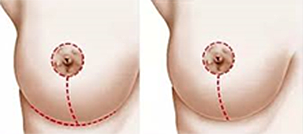Breast reduction surgery is usually performed through incisions on your breasts and then the excess fat, glandular tissue and skin are removed. At the HAPSI we have extensive experience the safest most modern techniques available today.
The most common techniques used at the HAPSI are:
- the “lollipop scar” Vertical breast reduction
- the “anchor scar” Inferior pedicle technique
The details of these techniques are individualized for each woman and the exact architecture for your breasts will be determined by your individual composition of gland and fat, the amount of extra skin, the degree of reduction desired and your surgeon’s advice in terms of which approach is safe and can provide a natural, predictable shape.
In some cases, excess fat may be removed through liposuction only but this is not a common technique as it is indicated mainly for women with large breasts but no extra skin or breast ptosis. If breast size is largely due to fatty tissue and excess skin is not a factor, liposuction alone may be used for breast reduction.
Light anesthesia medications are administered for your comfort during breast reduction surgery. The choices include intravenous sedation and light general anesthesia which is more common. Your HAPSI doctor will recommend the best choice for you.
Breast reduction usually takes approximately 3 hours.
VERTICAL BREAST REDUCTION TECHNIQUE (“lollipop incision”)
This technique is used in moderately large breasts and not in cases of significant or severe macromastia.
As shown in the picture, a keyhole incision around the nipple is created and then vertically down to the breast crease. Then the excess breast gland and fat are removed. The nipple remains attached to a segment of breast tissue at the upper area (superior pedicle) in order to get blood supply and remain viable. Skin is also removed from the lower breast and the nipple is then repositioned in a higher position. The areola is reduced by excising skin at the perimeter, if necessary.
The incisions are brought together to reshape the now smaller breast. Sutures are placed in layers deep within the breast tissue to create and support the new form and also more superficially in order to minimize the tension on the skin level as this prevents intense scarring. Finally special surgical papertape (steri-strips) are placed in order to cover the skin incision. The scar has a “lollipop shape” around the nipple and down to the breast crease. The incision lines are permanent, but in most cases will fade and significantly improve over time.

INFERIOR PEDICLE BREAST REDUCTION TECHNIQUE (“anchor incision”)
This technique is the most frequently used technique as it is indicated in significant or severe macromastia.
As shown in the picture, an anchor-type incision around the nipple is created that then follows a course vertically down to the breast crease and then horizontally along the low breast crease. Then the excess breast gland and fat are removed. The nipple remains attached to a segment of breast tissue at the lower area (inferior pedicle) in order to get blood supply and remain viable. Significant amount of skin is removed from the breast and the nipple is then repositioned in a higher position. Usually it is necessary to reduce the areola size by excising skin at the perimeter.
The incisions are brought together to reshape the now much smaller breast. Sutures are placed in layers deep within the breast tissue to create and support the new form and also more superficially in order to minimize the tension on the skin level as this prevents intense scarring. Finally special surgical papertape (steri-strips) are placed in order to cover the skin incision. The extensive scar has an “anchor shape” around the nipple, down to the breast crease and horizontally at the breast crease. The incision lines are permanent, but in most cases will fade and significantly improve over time.







